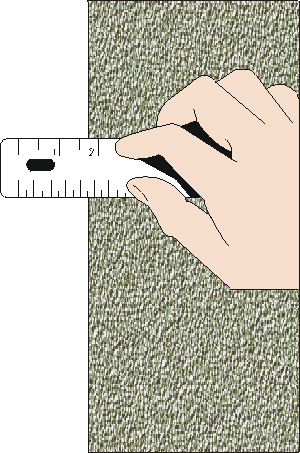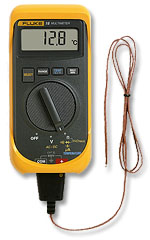Error Analysis in Experimental Physical Science
§6 - The Reading Error
 In the previous section we
saw that when we repeat measurements of some quantity in which random
statistical factors lead to a spread in the values from one trial to the next,
it is reasonable to set the error in each individual measurement equal to the
standard deviation of the sample.
In the previous section we
saw that when we repeat measurements of some quantity in which random
statistical factors lead to a spread in the values from one trial to the next,
it is reasonable to set the error in each individual measurement equal to the
standard deviation of the sample.
Here we discuss another error that arises when we do a direct
measurement of some quantity: the reading error.
For example, to the right we show a measurement of the position of the
left hand side of some object with a ruler. The result appears to be just a bit
less than 1.75 inches.
We shall assume that the ruler is perfectly constructed. This assumption
is discussed further in Section 12.
To determine the reading error in this measurement we have to answer the
question: what is the minimum and maximum values that the position could
have for which we will not see any difference? There is no fixed rule that
will allow us to answer this question. Instead we must use our intuition and
common sense.
Could the value actually be as large as 1.75? Perhaps, but almost
certainly no larger. Could the value be as small as 1.70? Very unlikely. How
about 1.73? Perhaps, but probably no smaller. Thus a reasonable estimate of the
reading error of this measurement might be ± 0.01 inches. Then we would
state that the position is 1.74 ± 0.01 inches.
For your eyes and computer monitor with which you are looking at the
above measurement, you may wish to instead associate a reading error of 0.02
inches with the position; this is also a reasonable number. A reading error of
0.03 inches, though, is probably too pessimistic. And a reading error much less
than 0.01 is probably too optimistic.
|
To the right we show the same measurement, but with two
differences. First it is smaller. Second the person doing the measurement needs
to clean their glasses.
It seems fairly obvious that the reading error for this
measurement will be larger than for the previous one. |
 |
We assume that the reading error indicates a spread in repeated
measurements, just like the standard deviation discussed in the previous
section. However, here natural human biases means that each repeated
measurement should be done by a different person. So if we get a collection of
objective observers together to look at the first measurement above, we expect
most but perhaps not all observers will report a value between 1.73 and 1.75
inches. (Of course, in real life seldom if ever do we actually get a collection
of observers together so that we may determine the reading error of a simple
measurement.)
Note that there is often a trade-off when assigning a reading error such
as above. On the one hand we want the error to be as small as possible,
indicating a precise measurement. However we also want to insure that measured
value probably lies within errors of the "true" value of the quantity, which
means we don't want the error to be too small.
Exercise 6.1. Choose your textbook or some other
hardcover book and measure its thickness. What is the reading error in this
measurement? Repeat the measurement a few times at different places on the
book. What is the estimated standard deviation of your measurements?
For a measurement with an instrument with a digital readout, the reading error
is "± one-half of the last digit."
|
We illustrate with a digital thermometer shown to the right.
The phrase "± one-half of the last digit" above is the
language commonly used in manufacturer's specification sheets of their
instruments. It can be slightly misleading. It does not mean one half
of the value of the last digit, which for this example is 0.4.
It means one-half of the power of ten represented in the last digit. Here,
the last digit represents values of a tenth of a degree, so the reading
error is 1/2 x 0.1 = 0.05.
This is saying that the value is closer to 12.8 than to 12.7 or 12.9.
It assumes that the engineer who designed the instrument has made it round
measurements correctly in the display.
Finally, then we would write the temperature as 12.80 ± 0.05 oC. |
 |
 |
One sometimes sees statements that the reading error
of an analog instrument such as a meter stick is something like ±
one-half of the smallest scale marking. These and similar statements are wrong!
The reading error of such an analog instrument can only be determined by the
person reading the instrument, and can sometimes be different for different
people. |
 |


This document is Copyright © 2001, 2004
David M. Harrison
This is $Revision: 1.8 $, $Date: 2004/07/18 16:46:52 $
(year/month/day) UTC.
 In the previous section we
saw that when we repeat measurements of some quantity in which random
statistical factors lead to a spread in the values from one trial to the next,
it is reasonable to set the error in each individual measurement equal to the
standard deviation of the sample.
In the previous section we
saw that when we repeat measurements of some quantity in which random
statistical factors lead to a spread in the values from one trial to the next,
it is reasonable to set the error in each individual measurement equal to the
standard deviation of the sample.

